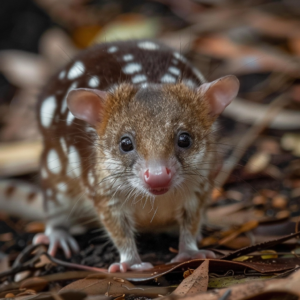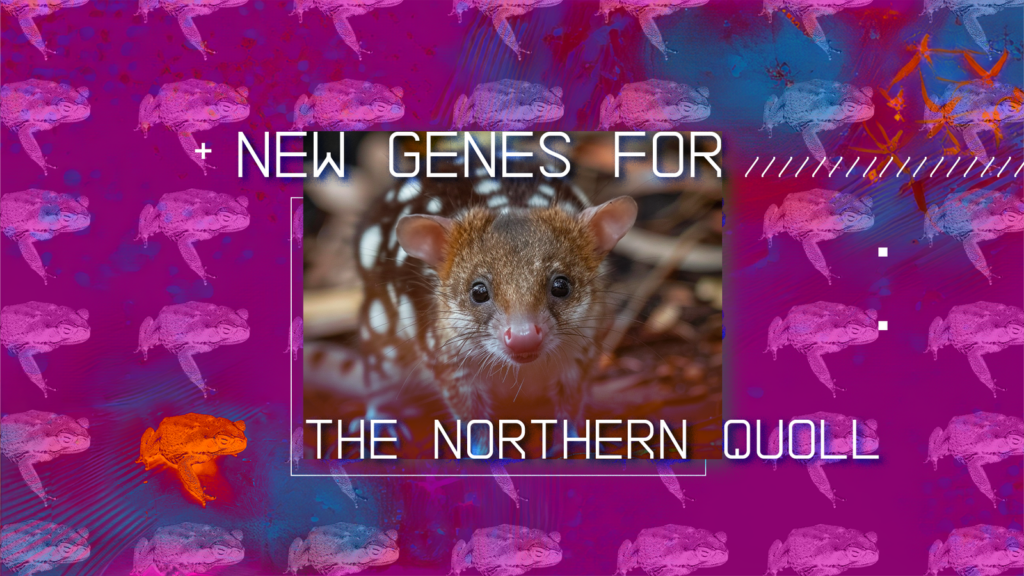From Queensland to the Northern Territory, New South Wales, and Western Australia, wildlife throughout Australia is under threat, but not from the usual subjects. The cane toad — scientific name: Rhinella marina — is a large, poisonous, and predatory species native to South and Central America that’s been ravaging the Down Under ecosystem since its introduction in the 1930s and continues to expand its range westward throughout the country at a rate of 40 to 60 kilometers per year.
And this spells disaster for Australia’s fuzzy, pink-nosed marsupial quolls.
Voracious Eaters and Prolific Breeders

A close-up photograph of a cane toad, prominently displaying its textured skin and the distinctive glands behind its eyes, which secrete the toxic bufotoxin.
As the world’s largest toad species, cane toads have a voracious appetite and no natural predators, a dangerous combination that has allowed them to take over the Australian ecosystem with ease.
Cane toads are opportunistic predators that will eat almost anything they can swallow, with adults known to consume up to 200 food items per night.
With a single female laying up to 60,000 eggs per year, there are estimates of over 200 million toads currently living in Australia, some as far as 2,000 kilometers from where they were first introduced. Simply put, native species cannot compete with the cane toad as the species outbreeds and out eats everything in its path.
This has spelled disaster for the Down Under, as the species already covers a land area greater than France and Spain combined, and threatens important species including bees, native tadpoles, and even large predators like crocodiles and the northern quoll with its deadly bufotoxin.
With the Australian government going so far as to state that “there is unlikely to ever be a broad-scale method available to control cane toads across Australia,” the cane toad has attracted the attention of conservationists around the world, many of whom are looking at unique solutions to this hostile takeover.
The Toad and the Quoll
When cane toads colonize a new area, many local predators initially consider them a convenient meal. But with a milky poison known as bufotoxin released from its glands when threatened, cane toads have proven deadly to most animals willing to taste-test, from freshwater crocodiles to monitor lizards, dingoes, and northern quolls.
“They’re absolutely catastrophic for large predators,” said Rick Shine, an evolutionary biologist at the University of Sydney and cane toad expert. “We get some figures like 95% mortality within the first two months of the toad’s arrival.”
While the Australian government has accepted that it can’t control cane toad populations, something must be done to combat the astronomical impact on the local ecosystems and wildlife that are often ill-equipped to deal with the invasive toad’s unique traits. As part of our partnership with The University of Melbourne, the scientists at Colossal Biosciences are working toward this solution, and we’ve made recent breakthroughs using gene editing to protect beloved marsupials like the dunnart and northern quoll from the cane toad’s deadly poison.

This close-up image shows a northern quoll in its natural habitat, alert and looking directly at the camera.
The northern quoll, or Dasyurus hallucatus, is a cat-sized, nocturnal marsupial and one of the species that’s been particularly impacted by the cane toad. Native to the rocky slopes, woodlands, and forests along the northern Australian coast, the northern quoll can be found from Western Australia through the Northern Territory to southeastern Queensland.
As a mesopredator and opportunistic omnivore, northern quolls occupy an important ecological niche, eating everything from small rodents, reptiles, and birds to local fruits and nectars. With cane toads currently occupying 60% of the northern quoll’s range, the quoll has unsurprisingly incorporated the invasive species into its diet — and the results have been unsavory. The northern quoll has experienced dramatic population losses since the cane toad’s introduction to its range, as just one bite of the toad contains enough poison to be fatal.
“If you’re a quoll or a large goanna, the first toad you meet will probably be a very large one,” said Shine, “and so it will probably be the last toad you meet.”
Today, the northern quoll has experienced a 75% reduction in its historic range and is confined to six small geographic centers. In Queensland, where the cane toad was first introduced, the northern quoll’s population has dropped by almost 95% since 1935, with studies finding that the north Queensland subspecies, the northern spotted-tailed quoll, is down to its last 220 individuals.
A Tiny Tweak for a Colossal Advantage
With the cane toad moving quickly through the Kimberley — a remote section of Western Australia where one of the last strongholds of northern quoll is thriving — scientists with Colossal and the University of Melbourne are working fast to change just two letters of the quoll’s DNA and establish toxin resistance in the species.
“It’s just a tiny tweak,” says Dr. Stephen Frankenberg, a University of Melbourne scientist working on the project. “It’s done routinely in lab animals all the time … Over thousands of years, maybe some Australian species will gradually evolve that resistance. But the risk is they would be more likely to go extinct first.”
Over the past two years, scientists working in collaboration with Colossal at the University of Melbourne have been developing the resources and technology necessary for this project, including establishing information like a reference genome from northern quoll tissue samples and perfecting the ability to make genetic edits on the dunnart — a close relative to the northern quoll considered a lab-based marsupial model species — with husbandry requirements and a reproductive cycle favorable for developing robust gene edits.
The team has recently engineered toxin resistance in dunnart cells by introducing traits found in the toad’s natural predators from South America. This represents a major breakthrough toward protecting Australia’s ecosystems, as it acts as a stepping stone for developing toxin resistance in other marsupials and susceptible animals.
The University of Melbourne and the team at Colossal are now working to introduce toxin resistance to northern quoll communities using eight cell lines that have been established from pouch young. These cells are currently being reprogrammed into iPSC cells — a pluripotent cell crucial for gene editing — as it can be reprogrammed into any type of cell. Once generated, these iPSC cells will allow for precise cellular-level edits of the northern quoll’s genome, ensuring a hereditary resistance to bufotoxin.
This project is being led by Andrew Pask, Ph.D., Colossal’s scientific advisor and professor of biosciences at the School of Biosciences at the University of Melbourne. Pask runs the university’s Thylacine Integrated Genomic Restoration Research (aka TIGRR) Laboratory, dedicated to developing innovative approaches to marsupial conservation and restoration, a key bastion of Colossal’s efforts to revive the thylacine.

Andrew Pask, Ph.D., Colossal’s scientific advisor and professor of biosciences at the School of Biosciences at the University of Melbourne, cradles a dunnart in his hands. A dunnart is a close relative to the northern quoll. (Photo: The University of Melbourne)
He and the team at Colossal believe that these advancements in gene editing can inform additional efforts to conserve marsupials, including engineering resistance to devil facial tumors, the infectious and transferrable cancer responsible for an 80% decline in Tasmanian devil populations.
“We need northern quolls to have a balanced ecosystem in mainland Australia,” shared Pask. “By using Colossal’s technology we’re giving our conservation partners a fighting chance of succeeding in restoring that balance.”
With Australia leading the world in mammal extinctions, we must do everything in our power to safeguard the country’s fragile ecological diversity and ecosystem health. Projects like this provide invaluable benefits to local wildlife, giving them a fighting chance at survival while encouraging the cautious predation of one of Australia’s most invasive species.
About The Author

Sara Ord, Director of Species Restoration
Sara Ord, Director of Species Restoration at Colossal, is focused on advancing science and technology to change the way we protect endangered species. Sara received her Master’s degree in Chemical and Biomolecular Engineering from Johns Hopkins University where she focused on building integrated materials with chemical information processing mechanisms, inspired by biology. Previously, Sara was a researcher at Hypergiant, where she focused on advancements of chemical and molecular processes in space.
Sara has a Bachelor of Science from California State University, Fullerton where she majored in biological sciences, with a concentration in cellular and developmental biology. Her research has focused on fundamental questions in molecular evolution related to cellular adaptation and response to stress, where she co-authored two papers. Prior, Sara worked at St. David’s Hospital as a pathologist assistant where she gained hands-on experience in the field of histology.
Sara has a passion for science, environmental conservation and the representation of ideas encompassed in these fields. Her work at Colossal aims at the advancement of these ideas through research.



